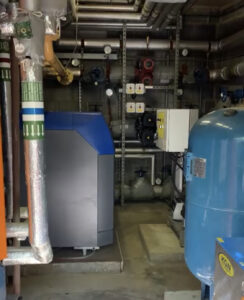I. Introduction
A. Brief Overview of Alfred Salter Primary School
Alfred Salter Primary School, nestled in the heart of our vibrant community, has been a beacon of education for generations. The school’s commitment to academic excellence, combined with a nurturing environment, has made It a cherished institution for families in the area. With a diverse and dedicated team of educators and a passionate student body, it continuously strives to create an environment where learning thrives.
B. Importance of a Well-Functioning Heating System in Educational Institutions
A warm and comfortable environment plays a pivotal role in fostering effective learning and teaching experiences. For educational institutions like Alfred Salter Primary School, a well-functioning heating system is more than just a matter of comfort; it’s essential for the overall well-being and productivity of our students and staff.
In the colder months, maintaining an optimal temperature is critical to ensure that our students can focus on their studies without the distraction of being too cold. It also promotes a healthier atmosphere by reducing the risk of illnesses associated with temperature extremes. Moreover, a well-regulated indoor climate contributes to a positive and conducive environment for learning and working.
C. Purpose of the Case Study
The purpose of this case study is to shed light on a recent project undertaken by Alfred Salter Primary School to improve our heating system. In this endeavor, we installed a new water heater, serviced our plant room, and replaced valves and the heating pump. The case study will delve into the details of these crucial upgrades, their impact on our school, and how they align with our commitment to providing the best possible educational environment for our students and staff.
Table of Contents
II. Background
A. Historical Heating System at Alfred Salter Primary School
For many years, the heating system at Alfred Salter Primary School faithfully served the needs of our students and staff. However, as time passed, it became clear that this aging system was in need of significant attention and upgrades.
The school’s old heating system had served diligently but was showing signs of age and wear. Key components such as valves had seized up, the heating pump had broken down, and the boilers were in a state of disrepair. These issues not only resulted in inconsistent heating throughout the school but also led to increased energy consumption and maintenance costs. The situation had reached a point where the reliability of the heating system was compromised, impacting the comfort and well-being of our school community.
B. Challenges and Issues Faced by the School
The challenges posed by the deteriorating heating system were not taken lightly. Alfred Salter Primary School is committed to providing a safe and conducive environment for learning and growth. However, the issues with the heating system were hindering our ability to fulfill this commitment. The challenges and issues faced by the school included:
- Inconsistent Heating: Some areas of the school were significantly colder than others due to malfunctioning valves and a broken heating pump, making it difficult for students and staff to focus on their tasks.
- Increased Energy Costs: The old, inefficient heating system was consuming more energy than necessary, resulting in rising energy bills that strained the school’s budget.
- Maintenance Costs: Frequent breakdowns and the need for extensive repairs were taking a toll on the school’s maintenance budget, diverting resources from other essential areas of improvement.
- Environmental Impact: An inefficient heating system was not only financially burdensome but also had a negative impact on our commitment to sustainability and reducing our carbon footprint.
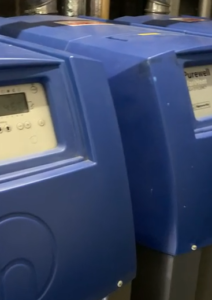
III. Project Planning
A. Needs Assessment and Analysis
Before embarking on the comprehensive heating system upgrade project at Alfred Salter Primary School, a thorough needs assessment and analysis were conducted. Paul, our dedicated surveyor, played a pivotal role in this initial phase of project planning.
Paul worked closely with the school administration to understand the specific heating issues and challenges faced by the institution. This involved examining the existing heating infrastructure, conducting site inspections, and engaging in extensive consultations with school staff and administrators. The needs assessment revealed the critical components of the heating system that required attention, including seized valves, a broken heating pump, broken boilers, and a gas-fired hot water cylinder in disrepair.
Paul’s expertise as a surveyor enabled the project team to pinpoint the exact areas in need of improvement, ensuring that the upgrades would directly address the school’s heating deficiencies. This meticulous analysis served as the foundation upon which the project was built, guaranteeing that the solutions implemented were tailored to the school’s unique requirements.
B. Budget Allocation and Funding Sources
After the needs assessment was complete and the scope of work defined, the next crucial step was to allocate the necessary budget and identify funding sources for the project. Paul’s expertise was instrumental in determining the budgetary requirements accurately.
Working alongside the school administration, Paul helped create a detailed budget that encompassed all aspects of the project, including the cost of the new water heater, servicing the plant room, replacement of valves and the heating pump, and the repair of the boilers. Moreover, the budget factored in contingency funds to account for unforeseen challenges that might arise during the project’s execution.
Paul also played a vital role in identifying potential funding sources. This included exploring grant opportunities, seeking energy efficiency incentives, and considering contributions from the school’s budget. His diligent efforts ensured that the project’s financial aspects were well-managed and aligned with the school’s financial capabilities.
C. Selection of Contractors and Suppliers
With the needs assessment completed and the budget allocated, the next critical step was briefing the team and suppliers for the heating system upgrade project. Paul’s role extended to this phase, where his expertise proved invaluable.
Paul leveraged his industry knowledge to identify reputable suppliers with a proven track record in supply heating system components for commercial buildings. He also collaborated with suppliers to source high-quality components and equipment needed for the project, ensuring that only the best materials were used to enhance the school’s heating system.
The selection of suppliers was a meticulous process that Paul guided, prioritising reliability, efficiency, and cost-effectiveness to ensure the successful execution of the project.
D. Project Timeline
A well-defined project timeline is essential for ensuring that the heating system upgrades were completed efficiently and with minimal disruption to the school’s operations. Paul, as the project liaison, played a central role in developing and managing the project timeline.
Working closely with the engineering team, suppliers, and school staff, Paul established a detailed project schedule. This timeline included milestones, deadlines, and checkpoints to monitor progress effectively. Clear communication and coordination were maintained throughout the project to keep it on track and ensure that any unexpected delays or issues were promptly addressed.
The project timeline was a critical tool in ensuring that the heating system upgrades were executed seamlessly, allowing the school to enjoy the benefits of an improved heating system as quickly as possible.
In the next sections of this case study, we will explore the implementation of the heating system upgrades and the remarkable outcomes achieved through this meticulous project planning process led by Paul.

IV. Implementation
A. Description of the New Boiler System
The heart of any heating system lies in its boilers, and at Alfred Salter Primary School, we recognized the need for a substantial upgrade. In this phase of the project, we undertook extensive repairs to the existing Hamworthy boilers to ensure their functionality and efficiency.
Three Hamworthy boilers, which had been showing signs of wear and tear, were meticulously examined by our skilled technicians. The repair process involved changing crucial parts to restore them to peak performance. These repairs not only extended the lifespan of the boilers but also contributed to improved energy efficiency, reducing our environmental footprint and operating costs.
In addition to the boiler repairs, parts of the flue were also repaired to ensure the safe and efficient exhaust of combustion gasses, complying with stringent safety regulations.
B. Installation Process and Challenges
The installation of the new components, including a commercial heating pump, three-port valve, and six gate valves, was a crucial aspect of the heating system upgrade. This phase of the project was carried out with precision and care to ensure the seamless integration of these components into the existing system.
Our dedicated team of commercial heating engineers and technicians, in close collaboration with our surveyor Paul, executed the installation process with meticulous attention to detail. Challenges such as coordinating the installation without disrupting the school’s daily activities were addressed through careful planning and scheduling.
The installation process also involved aligning the new components with the existing infrastructure, ensuring that they functioned harmoniously to provide consistent heating throughout the school premises.
C. Heating System Upgrades
The comprehensive heating system upgrades at Alfred Salter Primary School went beyond just repairing and replacing individual components. It involved a holistic approach to enhance the overall efficiency and reliability of the system.
The installation of a new commercial heating pump significantly improved the circulation of heated water, ensuring that every part of the school received a consistent supply of warmth. The introduction of a three-port valve allowed for better control of heating distribution, further enhancing comfort and energy efficiency.
Additionally, the installation of six gate valves allowed for precise control over different sections of the heating system, optimizing its performance and allowing for easier maintenance in the future.
One of the critical upgrades was the installation of a new Hamworthy gas-fired hot water cylinder. This component ensured a dependable supply of hot water for the school’s various needs, including bathrooms and kitchens, enhancing the overall functionality of the facility.
D. Safety Measures and Compliance with Regulations
Ensuring the safety of our students, staff, and the entire school community was paramount throughout the implementation of these heating system upgrades. Adherence to safety regulations and best practices was a top priority.
All repair and installation work was conducted in strict compliance with local safety regulations and industry standards. Our technicians were equipped with the necessary safety gear, and the work areas were properly cordoned off to minimise any potential hazards.
Regular inspections and quality checks were carried out to guarantee that the heating system upgrades met safety standards and posed no risk to the school environment.
In the following sections of this case study, we will explore the remarkable benefits and outcomes of these heating system improvements and how they have positively impacted the Alfred Salter Primary School community.
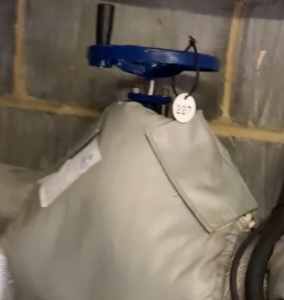
V. Benefits and Outcomes
In this section, we will discuss the significant benefits and outcomes of the heating system upgrades at Alfred Salter Primary School. These improvements have had a profound impact on the school’s operations, efficiency, and overall environment.
A. Improved Energy Efficiency
One of the most notable benefits of the heating system upgrades is the remarkable improvement in energy efficiency. The repairs to the existing boilers, along with the installation of new components like the commercial heating pump and three-port valve, have resulted in a more streamlined and energy-efficient heating system.
By optimising the distribution of heat and ensuring that the boilers operate at peak performance, we have substantially reduced our energy consumption. This not only translates to cost savings but also aligns with our commitment to environmental sustainability by reducing our carbon footprint.
B. Enhanced Comfort and Learning Environment
The heating system upgrades have transformed the learning and working environment at Alfred Salter Primary School. The introduction of precise temperature control through the three-port valve and gate valves has led to consistent and comfortable temperatures throughout the school premises.
Students and staff now benefit from a more comfortable and conducive environment for teaching and learning. No longer do they have to contend with chilly classrooms or uneven heating. This enhanced comfort promotes better focus and productivity, ultimately improving the overall educational experience.
C. Reduction in Maintenance Costs
Prior to the heating system upgrades, the school was grappling with the financial burden of frequent breakdowns and maintenance of the old system. However, with the repairs to the Hamworthy boilers and the installation of new, reliable components, maintenance costs have significantly decreased.
The improved reliability and efficiency of the heating system mean fewer unexpected repairs and less downtime. This translates to financial savings that can be redirected towards further enhancing the educational experience for our students.
D. Environmental Sustainability
Alfred Salter Primary School, are committed to sustainability and reducing their environmental impact. The heating system upgrades have played a crucial role in aligning the school with these values.
The reduced energy consumption, thanks to the improved efficiency of the heating system, not only benefits the school budget but also contributes to a greener future. By minimising the carbon emissions and conserving resources, they are doing their part to protect the environment and set an example for the students on the importance of responsible energy use.
The positive outcomes of these heating system upgrades have far-reaching effects, benefiting not only our school but also the larger community and the environment as a whole.

VI. Lessons Learned
As we reflect on the heating system upgrades at Alfred Salter Primary School, it’s essential to examine the valuable lessons we’ve gained from this project. These lessons encompass both our successes and achievements, as well as the challenges we encountered and overcame. Additionally, we’ll provide recommendations for future projects to ensure a smoother and more efficient school heating system.
A. Successes and Achievements
- Effective Staff Training: One of the key successes of this project was the training provided to the school staff on the use of the heating system. This training ensured that everyone was well-prepared to operate the system, reducing the likelihood of operational issues.
- Proactive Recommendations: Our team’s proactive approach in recommending further upgrades, such as the heating pump and pressurisation unit, demonstrated our commitment to the long-term efficiency and reliability of the heating system. The recent request from the school to proceed with these recommendations is a testament to the trust and confidence they have in our expertise.
- Collaboration with Caretaker Graham: The smooth coordination and collaboration with the school’s caretaker, Graham, played a crucial role in minimising disruptions during the project. By working closely with Graham and scheduling work around the school’s needs, we ensured that the project progressed efficiently without interfering with daily operations.
B. Challenges Faced and How They Were Overcome
- Coordination with School Schedule: Adhering to the school’s schedule while conducting repairs and installations presented a challenge. To address this, we maintained open lines of communication with the school administration and caretaker to schedule work during non-disruptive times, such as school breaks and after-hours.
- Budget Constraints: Like many projects, budget constraints were a challenge. To overcome this, we meticulously prioritise essential repairs and upgrades.
- Minimizing Disruption: Ensuring that the project had minimal disruption to the school’s daily activities required careful planning and coordination. Our team implemented strategies such as temporary heating solutions and phased installations to mitigate disruptions.
- Sustainability Focus: Incorporate sustainability principles into future projects by prioritising energy-efficient components and eco-friendly practices.
C. Recommendations for Future Projects
The Alfred Salter Primary School heating system upgrade project has been a journey of learning, collaboration, and positive outcomes. As we look forward to future projects, we will carry these lessons with us, ensuring that our commitment to excellence and the well-being of our school community continues to shine through in all our endeavors.
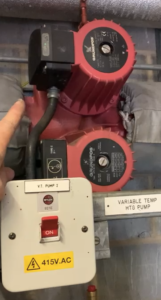
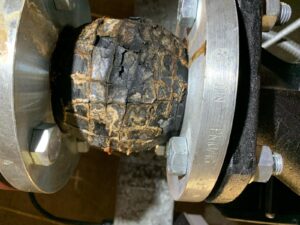
Emergency Commercial Heating Repair with Expertise and Efficiency
In the fast-paced world of commercial facilities management, emergencies can arise at any moment, putting operations and occupant comfort at risk. At Boilers 4 Essex, we understand the urgency of such situations and the need for swift, effective solutions. Recently, we were called to a London school facing a critical heating issue that threatened to disrupt daily operations and compromise the safety of students and staff. With our team of skilled engineers and dedication to excellence, we swiftly mobilised to address the problem and deliver efficient solutions that exceeded our client’s expectations.
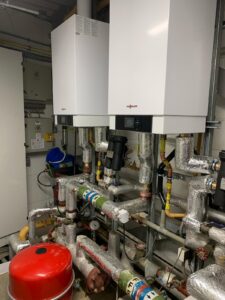
Commercial Boiler Installation London School
Recently, we had the privilege of working with a prominent London school to address issues with their commercial boiler system. Tasked with replacing two faulty units, our team approached the project with precision and expertise. Despite challenges, such as a condemned boiler and another underperforming unit, we devised a strategic plan that saved the school thousands of pounds while ensuring minimal disruption to their operations. Through meticulous planning and collaboration with the building management team, we successfully installed two powerful 60kW Viessmann boilers, each fitted with its own Adey Dual XP magnetic filter to enhance longevity and performance. From start to finish, our focus remained on delivering top-notch heating solutions, coupled with comprehensive training and certification for the school’s staff. The result? A delighted customer with a reliable heating system that meets their needs for years to come. Trust Boilers 4 Essex for your heating needs – where excellence is our standard.
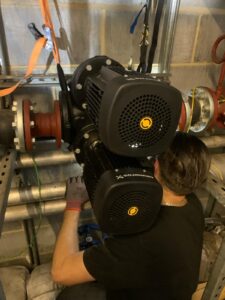
Commercial Heating Pump Installation In London School
Recently, our team at Boilers 4 Essex embarked on a crucial project at a renowned London school. The task at hand? Replacing a deteriorating heating pump that was causing significant disruptions to the school’s heating system. Despite the challenges posed by the malfunctioning pump, our skilled professionals rose to the occasion. With precision and efficiency, we installed two new 3 phase twin-headed commercial heating pumps, ensuring uninterrupted warmth for the students and staff. Our commitment to delivering reliable heating solutions was unwavering, and we’re proud to have kept the heating on throughout the installation process. Learn more about our seamless project and dedication to excellence in our latest blog post.

